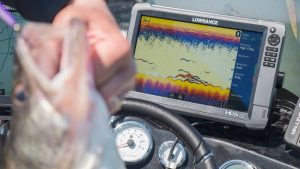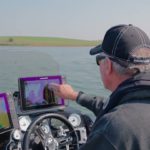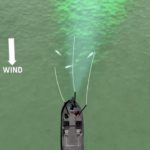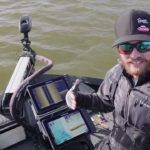Warm Water Walleyes
Although walleyes are known as a “cold water” fish, in the spring it seems that they can’t get warm enough! When the water temperature is less than 60 degrees, begin your search for walleyes in shallow areas of the lake. Typically anywhere that has less than five feet of water is the first place where vegetation begins to grow, which draws in baitfish, which will be followed by the walleyes.
Shallow water does make it hard to mark fish with electronics, but they still play a key role in finding fish locations. We like to use the Structure Scan feature on our Lowrance HDS in these situations to pinpoint shallow water transition areas, such as rock to sand transitions or emergent weeds. It is also important to pay close attention to the water temperatures as you drive around, even one or two-degree change could be all it takes to draw fish in!
Of course, you need to have fish in an area if you are going to catch them. While looking for fish can be tedious, if you hone in on a few general areas, you will increase your chances of success! The first place to look is areas that are wind-blown. These spots have two things going for them – warm surface water that is being pushed into a shallow area and a lake bottom that is being stirred up. Once the small microorganisms on bottom begin to stir, the baitfish will follow and really get activity going!
Don’t ignore the backs of bays either, when looking for fish. Really good spots may have slightly deeper water, about 8-10 feet deep, closer to the shallow water flats or shoreline taper. Finally, if you are fishing a body of water that has any kind of incoming warm water, such as a warm water discharge, creek, or a river that came out of a marsh, pay close attention to them, as these areas can also hold walleyes.
One of our favorite techniques to catch these shallow fish in the spring of the year is casting cranks. It is a great way to cover water in search of active walleyes. Start by turning on the “Heading Lock” feature on the MotorGuide Xi5 bow mount trolling motor, which will keep you on course in the direction your motor is pointed. This will allow you to work quickly along a shoreline or weed edge that appears to have the potential for holding an active school of fish.
Stick with more subtle action cranks, such as #4 or #5 Flicker Shad or #5 Flicker Minnow. Cast them using 8lb. FireLine Carrier 8 line with a 2-foot 10lb. Berkley 100% Professional Grade Fluorocarbon leader. This no-stretch mainline will allow you to feel the subtle vibration of these small baits. Even more important, you will be able to feel when a fish swipes at a bait. As the fish disrupts the water around the bait, there will be a short pause in the vibration of the lure. Often a good tactic at this point is to pause the bait and pop the rod tip to make the crank jump around in place. Then continue with your normal retrieve. This jumping around mimics a wounded baitfish and often entices a bite.
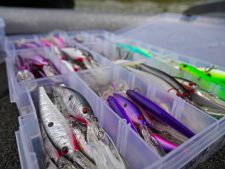
If you get several swipes, as you are casting, or better yet a bite, it is time to hit Anchor on your trolling motor. This will hold you in place while you thoroughly work the area. After making a few more casts with the crank, don’t hesitate to put on a light jig and really work the area over. A 1/8 ounce Bass Pro Shops Walleye Angler XPS jig tipped with a live minnow is an obvious choice, but don’t be afraid to mix things up a little. Even though it may be a little too early in the year to find crawlers at a bait shop, walleyes always have an appetite for them. You can pull out a Berkley PowerBait Jig Worm, a 3″ Gulp! Fry, or a 4″ Gulp! Crawler, as a great alternative to the real deal. One of the most deadly tails is the 2.5 inch, or 3 inch Gulp! Minnow, in the watermelon pearl color.
Start out with a subtle jigging action – a simple lift, pause, drop action often works best. By pausing on the top of the rod sweep, the jig will swim just above the bottom, right in the strike-zone. The use of a no-stretch line like Berkley NanoFil, allows you to detect the subtle bite of a walleye sucking in the jig. As soon as you feel something, set the hook!
If the fish are biting the jig and bait combo, it is a great time to push the envelope by getting more aggressive with a jig and action tail. By action, we mean something like a PowerBait Ripple Shad, a PowerBait Pro Shad or a PowerBait Ribworm.
